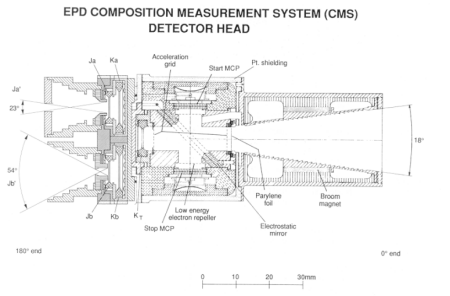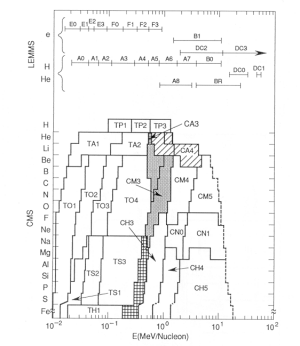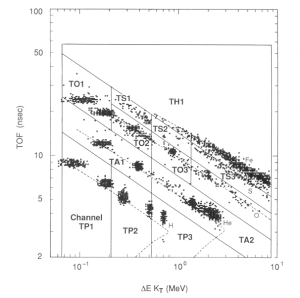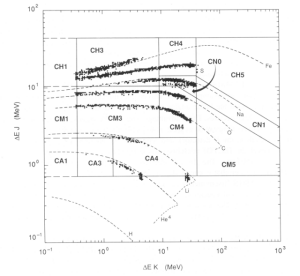GALILEO
The Galileo Energetic Particles Detector
From Space Science Reviews
CMS
The Composition Measurement System
The CMS is designed to measure the composition in the Jovian environment from energies of >~10 keV/nucl to >10 MeV/nucl. This system contains two types of energetic particle telescopes, shown here.
 |
Detail of the EPD CMS detector head. |
A small time-of-flight (TOF) telescope looks in the zero
degree direction while a pair of deltaE x E solid state
detector telescopes (JK detectors) covering higher energies
are oriented in the 180 degree direction. Energy coverage is
summarized here.
CMS Channel Descriptions
Channel Species Energy Range Geometric Factor Name (MeV nucl^-1) (cm**2 sr) ------------------------------------------------------------------------ TOF x E ------------------------------------------------------------------------ TP1 protons 0.08-0.22 0.007 TP2 protons 0.22-0.54 0.007 TP3 protons 0.54-1.25 0.007 TA1 alphas 0.027-0.155 0.007 TA2 alphas 0.155-1.00 0.007 TO1 medium nuclei 0.012-0.026 0.007 TO2 medium nuclei 0.026-0.051 0.007 TO3 medium nuclei 0.051-0.112 0.007 TO4 medium nuclei 0.112-0.562 0.007 TS1 intermediate 0.016-0.030 0.007 TS2 intermediate 0.030-0.062 0.007 TS3 intermediate 0.062-0.31 0.007 TH1 heavy nuclei 0.02 -0.20 0.007 TACS singles STARTS rates KtS ------------------------------------------------------------------------ Delta E x E ------------------------------------------------------------------------ CA1 alphas 0.17- 0.49 CA3 alphas 0.49- 0.68 CA4 alphas 0.68- 1.4 CM1 medium nuclei 0.16- 0.55 CM3 medium nuclei 0.55- 1.1 CM4 medium nuclei 1.1 - 2.9 CM5 medium nuclei 2.9 -10.7 CN0 intermediate 1.0 - 2.2 CN1 intermediate 2.2 -11.7 CH1 heavy nuclei 0.22- 0.33 CH3 heavy nuclei 0.33- 0.67 CH4 heavy nuclei 0.67- 1.3 CH5 heavy nuclei 1.3 -15.0 JaS singles rates JbS singles rates KS singles rates
 |
Block diagram of CMS analog electronics. |
Return to main
Galileo Table of Contents Page.
Return to Fundamental
Technologies Home Page.
Updated 8/23/19, Cameron Crane
QUICK FACTS
Manufacturer: The Galileo Spacecraft
was manufactured by the Jet Propulsion Laboratory,
Messerschmitt-Bölkow-Blohm, General Electric, and the
Hughes Aircraft Company.
Mission Duration: Galileo was planned to have a mission duration of around 8 years, but was kept in operation for 13 years, 11 months, and 3 days, until it was destroyed in a controlled impact with Jupiter on September 21, 2003.
Destination: Galileo's destination was Jupiter and its moons, which it orbitted for 7 years, 9 months, and 13 days.
Mission Duration: Galileo was planned to have a mission duration of around 8 years, but was kept in operation for 13 years, 11 months, and 3 days, until it was destroyed in a controlled impact with Jupiter on September 21, 2003.
Destination: Galileo's destination was Jupiter and its moons, which it orbitted for 7 years, 9 months, and 13 days.






